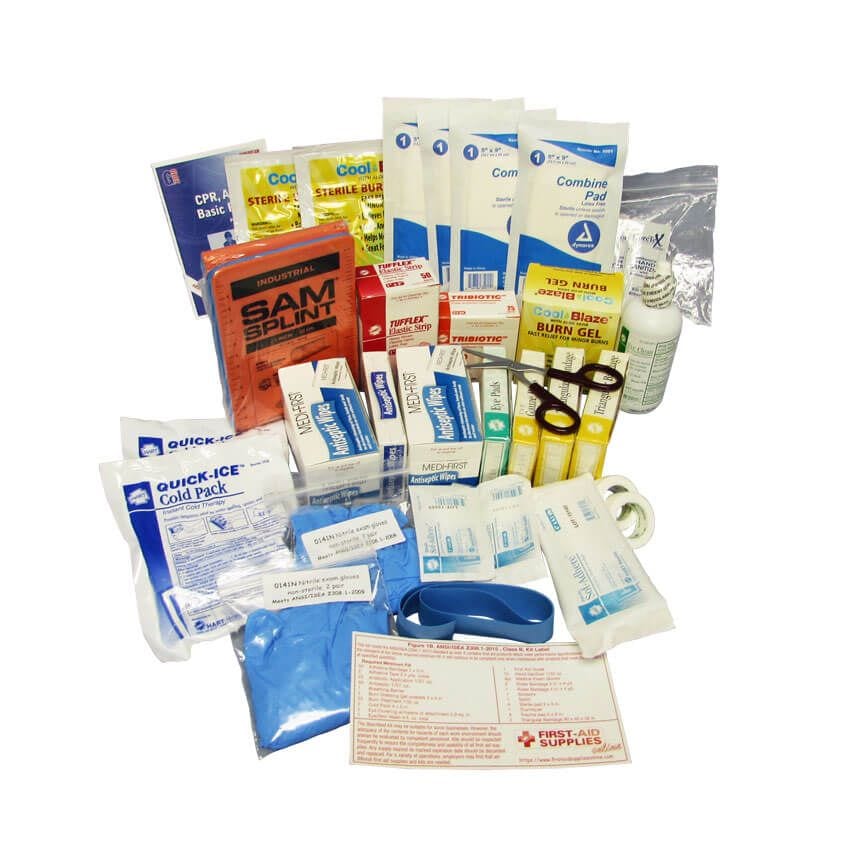ANSI Z308.1-2015 is Weighed in New “Safety” Standard

More evidence that ANSI Z308.1-2015 is creating havoc with this new “safety” standard in an earlier blog post. Here are some new observations that you might find interesting.
ANSI Z308.1-2015 has created two classes of workplace first aid kits. The Class A kit for the more common workplaces and the Class B where the situation may be a little more “complex” or “high-risk.” We examined those two types of kits in detail and came to the conclusion that there was very little difference between the two classes. The class B called for slightly larger quantities of products but the main difference between the two classes was that the class B kits required a splint and a tourniquet.
Let’s take them one at a time, the splint first. A class B kit means that you need to be prepared to splint a broken bone. So, assuming you have someone on your team who is capable of that, and you had the splint wouldn’t you just call 911? A vast majority of us would you bet but I acknowledge that there are work environments where emergency medical services are not available. So, I think here we have the answer to who needs a Class B kit. Anyone who works in a remote, isolated workplace without emergency services would need a Class B first aid kit.
The second item the tourniquet implies that you are working in an environment that is so hazardous that you need to keep a tourniquet in the first aid kit. (To stop life threatening arterial bleeding) Put that together with the splint and you can now add dangerous to remote and isolated without emergency services. This really narrows the field a bit, doesn’t it?
The new ANSI standard says nothing of substance about who would be required to purchase which type of first aid kit, they left it vague which is kind of leaving the door open where just about anything can and will come through that door.
This is a problem that is only made more difficult when you look at the standard itself as it pertains to these two items, again the splint first. The standard says, “6.17 Splint Each splint shall be padded, made of malleable material and shall be at least 4.0 inches X 24 inches. (As a side note this description comes very close to describing the famous Sam Splint which is both malleable and padded. (and radiolucent) and comes in two sizes 4-1/2″ X 18″ and 4-1/2″ X 36″). So, this standard essentially disqualifies the famous and popular Sam Splint. Why would they do that?????? The answer is that there is a splint out there that meets that description, and would you believe it, it’s a Sam Splint knock off? I can see that coming through the door.
For the tourniquet the standard has this, ” 6.19 Tourniquet Each tourniquet shall be at least 1 inch wide.” That’s it; they had a lot more to say about the splint which struck me as kind of strange. If I am working in a remote, isolated dangerous place without emergency services I want a much more robust tourniquet. Wait a minute, this is the 21st Century and there are some terrific 21st Century Stop bleeding products out there that I’d much prefer to a lousy 1-inch tourniquet. Need I point out that the tourniquet is old technology? Really old? Come on people; if you are working in an isolated, remote and dangerous work environment wouldn’t you really rather have a first aid kit filled with 21st century lifesaving products? Of course you would, and I am willing to bet that if you do your employer has gone far beyond what is required in ANSI Z308.1-2015 to provide you with those first aid essentials. In the event your work for a firm that doesn’t understand this, then you might want to bring your own kit with you or move to a safer workplace.
The moral of the story is that there will always be regulations, don’t look for them to make sense. More importantly don’t let them trump common sense for which there is no substitute.
Common sense says that a Class A kit is adequate for most workplaces. In the event that you do find yourself in that category that is isolated remote and without emergency medical services then you need more that a Class B kit can deliver. It’s just common sense.
